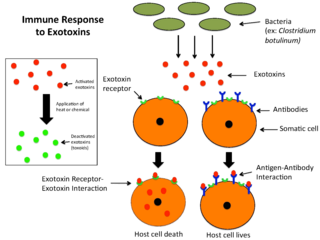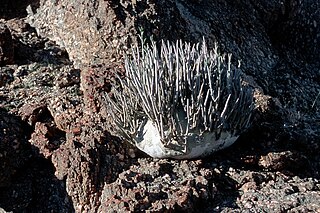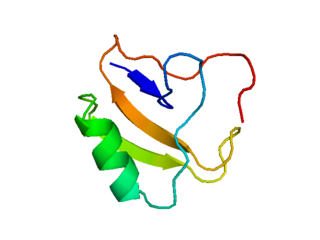Related Research Articles

Ricin ( RY-sin) is a lectin (a carbohydrate-binding protein) and a highly potent toxin produced in the seeds of the castor oil plant, Ricinus communis. The median lethal dose (LD50) of ricin for mice is around 22 micrograms per kilogram of body weight via intraperitoneal injection. Oral exposure to ricin is far less toxic. An estimated lethal oral dose in humans is approximately one milligram per kilogram of body weight.

Shiga toxins are a family of related toxins with two major groups, Stx1 and Stx2, expressed by genes considered to be part of the genome of lambdoid prophages. The toxins are named after Kiyoshi Shiga, who first described the bacterial origin of dysentery caused by Shigella dysenteriae. Shiga-like toxin (SLT) is a historical term for similar or identical toxins produced by Escherichia coli. The most common sources for Shiga toxin are the bacteria S. dysenteriae and some serotypes of Escherichia coli, which include serotypes O157:H7, and O104:H4.

An exotoxin is a toxin secreted by bacteria. An exotoxin can cause damage to the host by destroying cells or disrupting normal cellular metabolism. They are highly potent and can cause major damage to the host. Exotoxins may be secreted, or, similar to endotoxins, may be released during lysis of the cell. Gram negative pathogens may secrete outer membrane vesicles containing lipopolysaccharide endotoxin and some virulence proteins in the bounding membrane along with some other toxins as intra-vesicular contents, thus adding a previously unforeseen dimension to the well-known eukaryote process of membrane vesicle trafficking, which is quite active at the host–pathogen interface.

In cellular neuroscience, the soma, perikaryon, neurocyton, or cell body is the bulbous, non-process portion of a neuron or other brain cell type, containing the cell nucleus. Although it is often used to refer to neurons, it can also refer to other cell types as well, including astrocytes, oligodendrocytes, and microglia. There are many different specialized types of neurons, and their sizes vary from as small as about 5 micrometres to over 10 millimetres for some of the smallest and largest neurons of invertebrates, respectively.

Adenia is a genus of flowering plants in the passionflower family Passifloraceae. It is distributed in the Old World tropics and subtropics. The centers of diversity are in Madagascar, eastern and western tropical Africa, and Southeast Asia. The genus name Adenia comes from "aden", reported as the Arabic name for the plant by Peter Forsskål, the author of the genus.

Sodium channels are integral membrane proteins that form ion channels, conducting sodium ions (Na+) through a cell's membrane. They belong to the superfamily of cation channels.
Gliosis is a nonspecific reactive change of glial cells in response to damage to the central nervous system (CNS). In most cases, gliosis involves the proliferation or hypertrophy of several different types of glial cells, including astrocytes, microglia, and oligodendrocytes. In its most extreme form, the proliferation associated with gliosis leads to the formation of a glial scar.

Gelonin is a type 1 ribosome-inactivating protein and toxin of approximately 30 kDa found in the seeds of the Himalayan plant Gelonium multiflorum. In cell-free systems gelonin exerts powerful N-glycosidase activity on the 28S rRNA unit of eukaryotic ribosomes by cleaving out adenine at the 4324 site. Gelonin lacks carbohydrate-binding domains so it is unable to cross the plasma membrane, making it highly effective only in cell free systems.
Saporin is a protein that is useful in biological research applications, especially studies of behavior. Saporins are so-called ribosome inactivating proteins (RIPs), due to its N-glycosidase activity, from the seeds of Saponaria officinalis. It was first described by Fiorenzo Stirpe and his colleagues in 1983 in an article that illustrated the unusual stability of the protein.

Cathepsin E is an enzyme that in humans is encoded by the CTSE gene. The enzyme is also known as slow-moving proteinase, erythrocyte membrane aspartic proteinase, SMP, EMAP, non-pepsin proteinase, cathepsin D-like acid proteinase, cathepsin E-like acid proteinase, cathepsin D-type proteinase) is an enzyme.

40S ribosomal protein S25 (eS25) is a protein that in humans is encoded by the RPS25 gene.

Scorpion toxins are proteins found in the venom of scorpions. Their toxic effect may be mammal- or insect-specific and acts by binding with varying degrees of specificity to members of the Voltage-gated ion channel superfamily; specifically, voltage-gated sodium channels, voltage-gated potassium channels, and Transient Receptor Potential (TRP) channels. The result of this action is to activate or inhibit the action of these channels in the nervous and cardiac organ systems. For instance, α-scorpion toxins MeuNaTxα-12 and MeuNaTxα-13 from Mesobuthus eupeus are neurotoxins that target voltage-gated Na+ channels (Navs), inhibiting fast inactivation. In vivo assays of MeuNaTxα-12 and MeuNaTxα-13 effects on mammalian and insect Navs show differential potency. These recombinants exhibit their preferential affinity for mammalian and insect Na+ channels at the α-like toxins' active site, site 3, in order to inactivate the cell membrane depolarization faster[6]. The varying sensitivity of different Navs to MeuNaTxα-12 and MeuNaTxα-13 may be dependent on the substitution of a conserved Valine residue for a Phenylalanine residue at position 1630 of the LD4:S3-S4 subunit or due to various changes in residues in the LD4:S5-S6 subunit of the Navs. Ultimately, these actions can serve the purpose of warding off predators by causing pain or to subdue predators.

Quinolinic acid, also known as pyridine-2,3-dicarboxylic acid, is a dicarboxylic acid with a pyridine backbone. It is a colorless solid. It is the biosynthetic precursor to niacin.

A ribosome-inactivating protein (RIP) is a protein synthesis inhibitor that acts at the eukaryotic ribosome. This protein family describes a large family of such proteins that work by acting as rRNA N-glycosylase. They inactivate 60S ribosomal subunits by an N-glycosidic cleavage, which releases a specific adenine base from the sugar-phosphate backbone of 28S rRNA. RIPs exist in bacteria and plants.
Transneuronal degeneration is the death of neurons resulting from the disruption of input from or output to other nearby neurons. It is an active excitotoxic process when a neuron is overstimulated by a neurotransmitter causing the dysfunction of that neuron which drives neighboring neurons into metabolic deficit, resulting in rapid, widespread loss of neurons. This can be either anterograde or retrograde, indicating the direction of the degeneration relative to the original site of damage. There are varying causes for transneuronal degeneration such as brain lesions, disconnection syndromes, respiratory chain deficient neuron interaction, and lobectomies. Although there are different causes, transneuronal degeneration generally results in the same effects to varying degrees. Transneuronal degeneration is thought to be linked to a number of diseases, most notably Huntington's disease and Alzheimer's disease, and researchers recently have been performing experiments with monkeys and rats, monitoring lesions in different parts of the body to study more closely how exactly the process works.

Momordin or α-momorcharin is one of several related proteins isolated from several plants of the genus Momordica, which includes the bitter melon and the balsam apple.
Cucurmosin is a type I ribosome inactivating protein (RIP) found in the sarcocarp (flesh) and seed of Cucurbita — notably Cucurbita moschata, that is toxic to cancer cells, if the dosage is high enough, by stopping their ribosomes. Cucurmosin is what Cucurbita use to defend against viral, fungal, and bacterial agents. It takes a lower dose of cucurmosin to kill cancer cells than healthy cells. It has been shown to induce apoptosis in pancreatic cancer and myeloid leukemia cells.
AmmTX3, produced by Androctonus mauretanicus, is a scorpion toxin of the α-KTX15 subfamily. The toxin is known for its ability to act as a specific Kv4 channel blocker, and thereby reducing the A-type potassium current through this channel.
Modeccin is a toxic lectin, a group of glycoproteins capable of binding specifically to sugar moieties. Different toxic lectins are present in seeds of different origin. Modeccin is found in the roots of the African plant Adenia digitata. These roots are often mistaken for edible roots, which has led to some cases of intoxication. Sometimes the fruit is eaten, or a root extract is drunk as a manner of suicide.
Bolesatine is a glycoprotein isolated from the Rubroboletus satanas mushroom which has a lectin function that is specific to the sugar binding site of D-galactose. It is a monomeric protein with a compact globular structure and is thermostable. One tryptophan can be found in its primary sequence along with one disulfide bridge.
References
- ↑ Barbieri, Luigi; Falasca, Anna Ida; Stirpe, Fiorenzo (11 June 1984). "Volkensin, the toxin of Adenia volkensii (kilyambiti plant)". FEBS Letters. 171 (2): 277–279. Bibcode:1984FEBSL.171..277B. doi: 10.1016/0014-5793(84)80503-7 .
- 1 2 Gulino, Rosario (2016). "Neuroplasticity and Repair in Rodent Neurotoxic Models of Spinal Motoneuron Disease". Neural Plasticity. 2016: 1–11. doi: 10.1155/2016/2769735 . PMC 4735933 . PMID 26862439.
- 1 2 3 4 Barbieri, Luigi; Falasca, Anna Ida; Stirpe, Fiorenzo (1984-06-11). "Volkensin, the toxin of Adenia volkensii (kilyambiti plant)". FEBS Letters. 171 (2): 277–279. Bibcode:1984FEBSL.171..277B. doi: 10.1016/0014-5793(84)80503-7 . ISSN 0014-5793.
- ↑ Chambery, Angela; Di Maro, Antimo; Monti, Maurilia M.; Stirpe, Fiorenzo; Parente, Augusto (2003-12-09). "Volkensin fromAdenia volkensiiHarms (kilyambiti plant), a type 2 ribosome-inactivating protein". European Journal of Biochemistry. 271 (1): 108–117. doi: 10.1046/j.1432-1033.2003.03909.x . ISSN 0014-2956. PMID 14686924.
- ↑ Sparapani, Mauro; Buonamici, Laura; Ciani, Elisabetta; Battelli, Maria Giulia; Ceccarelli, Gianluca; Stirpe, Fiorenzo; Contestabile, Antonio (July 1997). <203::aid-glia4>3.0.co;2-8 "Toxicity of ricin and volkensin, two ribosome-inactivating proteins, to microglia, astrocyte, and neuron cultures". Glia. 20 (3): 203–209. doi:10.1002/(sici)1098-1136(199707)20:3<203::aid-glia4>3.0.co;2-8. ISSN 0894-1491. PMID 9215729. S2CID 19829553.